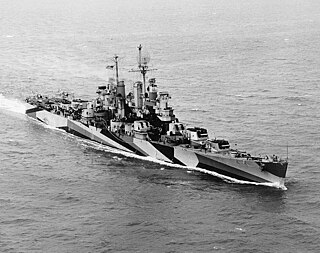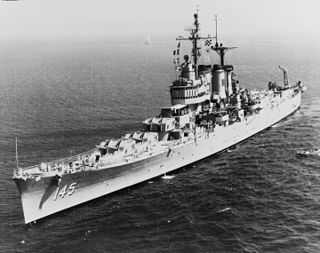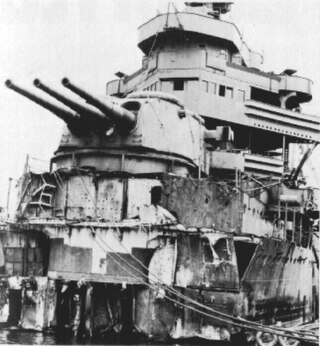
A heavy cruiser was a type of cruiser, a naval warship designed for long range and high speed, armed generally with naval guns of roughly 203 mm (8 inches) in calibre, whose design parameters were dictated by the Washington Naval Treaty of 1922 and the London Naval Treaty of 1930. Heavy cruisers were generally larger, more heavily-armed and more heavily-armoured than light cruisers while being smaller, faster, and more lightly-armed and armoured than battlecruisers and battleships. Heavy cruisers were assigned a variety of roles ranging from commerce raiding to serving as 'cruiser-killers,' i.e. hunting and destroying similarly-sized ships

USS Duluth was a Cleveland-class light cruiser of the United States Navy, which were built during World War II. The class was designed as a development of the earlier Brooklyn-class cruisers, the size of which had been limited by the First London Naval Treaty. The start of the war led to the dissolution of the treaty system, but the dramatic need for new vessels precluded a new design, so the Clevelands used the same hull as their predecessors, but were significantly heavier. The Clevelands carried a main battery of twelve 6-inch (152 mm) guns in four three-gun turrets, along with a secondary armament of twelve 5 in (127 mm) dual-purpose guns. They had a top speed of 32.5 knots.

The Northampton-class cruisers were a group of six heavy cruisers built for the United States Navy, and commissioned between 1928 and 1931.

USS North Carolina (ACR-12/CA-12) was a Tennessee-class armored cruiser of the United States Navy. The ship was built by Newport News Shipbuilding; she was laid down in March 1905, launched in October 1906, and was commissioned in May 1908. The final class of armored cruisers to be built for the US Navy, North Carolina and her sisters were armed with a main battery of four 10-inch (254 mm) guns, and were capable of a top speed of 22 knots.
Three ships of the United States Navy have been named USS Des Moines, after the city of Des Moines, Iowa.

The Alaska-class were six large cruisers ordered before World War II for the United States Navy (USN), of which only two were completed and saw service late in the war. The USN designation for the ships of this class was 'large cruiser' (CB), a designation unique to the Alaska-class, and the majority of leading reference works consider them as such. However, various other works have alternately described these ships as battlecruisers despite the USN having never classified them as such, and having actively discouraged the use of the term in describing the class. The Alaskas were all named after territories or insular areas of the United States, signifying their intermediate status between larger battleships and smaller heavy and light cruisers.

The Spruance-class destroyer was developed by the United States to replace the many World War II–built Allen M. Sumner- and Gearing-class destroyers, and was the primary destroyer built for the United States Navy during the 1970s and 1980s. It was named in honor of U.S. Navy Admiral Raymond A. Spruance, who successfully led major naval battles in the Asiatic-Pacific Theater during World War II such as the Battle of Midway and the Battle of the Philippine Sea.

USS Des Moines (CA-134) was the lead ship of the class of United States Navy (USN) heavy cruisers. She was the first USN ship to mount the auto-loading 8-inch (203 mm) Mark 16 guns, the first large-caliber auto-loading guns in the world. She was the second ship of the USN to be commissioned with the name of the city of Des Moines, capital of Iowa. Launched 1946, she was commissioned in 1948. She saw duty around the world until her decommissioning in 1961 when she was permanently mothballed. A 1981 survey was done to determine if she was worthy of reactivation for the 600-ship Navy, but the cost was too great so she remained in the reserve. She was struck from the Naval Vessel Register in 1993, which was followed by a campaign to turn her into a museum ship. The campaign failed, and in 2005 she was sold for scrapping, and she was broken up by July 7. Parts of the ship have been donated to various places for display, including at the USS Salem museum, which is the only Des Moines-class ship to avoid the scrapyard.

USS Newport News (CA–148) was the third and last ship of the Des Moines-class of heavy cruisers in the United States Navy. She was the first fully air-conditioned surface ship and the last active all-gun heavy cruiser in the United States Navy.

USS Salem (CA-139) is a Des Moines-class heavy cruiser completed for the United States Navy shortly after World War II and commissioned in 1949. The second ship of her class, she was the world's last heavy cruiser to enter service and is the last remaining. She was decommissioned in 1959 after serving in the Atlantic and Mediterranean. She is open to the public as a museum ship in Quincy, Massachusetts.

The Baltimore-class heavy cruisers were a class of heavy cruisers in the United States Navy commissioned during and shortly after World War II. Fourteen Baltimores were completed, more than any other class of heavy cruiser, along with another three ships of the Oregon City sub-class. The Baltimores also were the first cruisers in the US Navy to be designed without the limitations of the London Naval Treaty.

The Atlanta-class cruisers were eight United States Navy light cruisers which were designed as fast scout cruisers or flotilla leaders but which proved to be effective anti-aircraft cruisers during World War II. They were also known as the Atlanta-Oakland class. The Atlanta class originally had 16 x 5-inch (127 mm)/38 caliber guns in eight two-gun turrets, arranged with three superfiring turrets forward, three more superfiring aft and two waist mounts, one port and one starboard, giving the first four Atlanta-class cruisers the heaviest anti-aircraft armament of any cruiser of World War II. The last four ships of the class, starting with Oakland, had a slightly revised armament with a reduced main gun battery - the waist turrets being deleted - as they were further optimized for anti-aircraft fire in light of war experience.

The Benham class of ten destroyers was built for the United States Navy (USN). They were part of a series of USN destroyers limited to 1,500 tons standard displacement by the London Naval Treaty and built in the 1930s. The class was laid down in 1936-1937 and all were commissioned in 1939. Much of their design was based on the immediately preceding Gridley and Bagley-class destroyers. Like these classes, the Benhams were notable for including sixteen 21-inch (533 mm) torpedo tubes, the heaviest torpedo armament ever on US destroyers. They introduced a new high-pressure boiler that saved space and weight, as only three of the new boilers were required compared to four of the older designs. The class served extensively in World War II in the Atlantic, Mediterranean, and Pacific theaters, including Neutrality Patrols in the Atlantic 1940-1941. Sterett received the United States Presidential Unit Citation for the Battle of Guadalcanal and the Battle of Vella Gulf, and the Philippine Republic Presidential Unit Citation for her World War II service. Two of the class were lost during World War II, three were scrapped in 1947, while the remaining five ships were scuttled after being contaminated from the Operation Crossroads atomic bomb tests at Bikini Atoll in the Pacific.

The 3"/50-caliber gun in United States naval gun terminology indicates the gun fired a projectile 3 inches (76 mm) in diameter, and the barrel was 50 calibers long. Different guns of this caliber were used by the U.S. Navy and U.S. Coast Guard from 1900 through to 1990 on a variety of combatant and transport ship classes.

The Fargo-class cruisers were a modified version of the Cleveland-class cruiser design; the main difference was a more compact pyramidal superstructure with single trunked funnel, intended to improve the arcs of fire of the anti-aircraft (AA) guns. The same type of modification differentiated the Baltimore and Oregon City classes of heavy cruisers, and to a lesser degree the Atlanta and Juneau classes of light cruisers. Changes were made in order to reduce the instability of the Cleveland-class light cruisers, especially their tendency to roll dangerously. The main battery turrets sat about a foot lower and the wing gunhouses were lowered to the main deck. The medium (40 mm) anti-aircraft mounts were also lowered.

The 5"/25 caliber gun entered service as the standard heavy anti-aircraft (AA) gun for United States Washington Naval Treaty cruisers commissioned in the 1920s and 1930s. The goal of the 5"/25 design was to produce a heavy AA gun that was light enough to be rapidly trained manually. The gun was also mounted on pre-World War II battleships and aircraft carriers until replaced by the standard widespread dual-purpose 5"/38 caliber gun, which was derived from the 5"/25. Guns removed from battleships were probably converted for submarine use by late 1943, while a purpose-built variant for submarines was available in mid-1944, and was widely used by them. United States naval gun terminology indicates the gun fired a projectile 5 inches (127 mm) in diameter, and the barrel was 25 calibers long. It is referred to sometimes as a dual-purpose gun and sometimes as an anti-aircraft gun, because of its comparative weakness against surface targets.

The Worcester class was a class of light cruisers used by the United States Navy, laid down in 1945 and commissioned in 1948–49. They and their contemporaries, the Des Moines-class heavy cruisers, were the last all-gun cruisers built for the U.S. Navy. Ten ships were planned for this class, but only two were completed.

The 8"/55 caliber gun formed the main battery of United States Navy heavy cruisers and two early aircraft carriers. United States naval gun terminology indicates the gun barrel had an internal diameter of 8 inches (203 mm), and the barrel was 55 calibers long.

The CL-154 class of 5-inch (127 mm) gun light cruisers was a United States Navy project from the last two years of World War II, with antecedents reaching back to 1938 and earlier. The CL-154 class was contemporary to the 6-inch (152 mm) gun Worcester-class light cruisers and the 8-inch (203 mm) gun Des Moines-class cruisers: like them the CL-154 design incorporated the lessons learned of World War II combat. The Navy allocated six hull numbers to the CL-154 class for the planned construction, but unlike the Worcester and Des Moines classes the CL-154 class would be cancelled with no units named or constructed. Had these ships been built, they would have been given the hull classification CLAA on 18 March 1949.





















